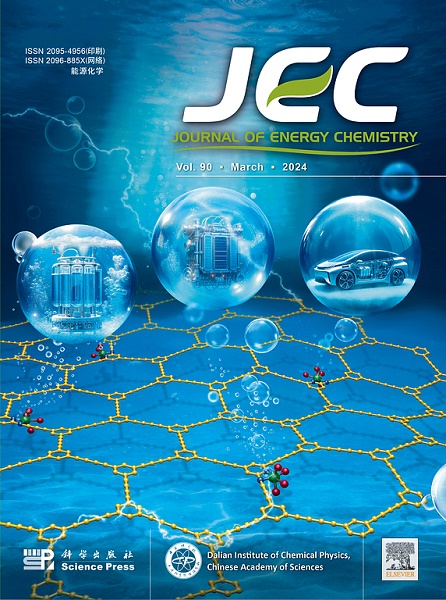Elucidating the role of ZrO2 in a cobalt catalyst in the direct hydrogenation of CO2 to C5+ hydrocarbons
IF 13.1
1区 化学
Q1 Energy
引用次数: 0
Abstract
Transforming CO2 into long-chain hydrocarbons that can be used in the current energy and chemical sectors is a promising pathway toward a circular carbon economy. However, the direct conversion of CO2 into C5+ hydrocarbons over Co-based catalysts is significantly challenging owing to the inherent high methanation activities of these catalysts. Herein, the incorporation of oxygen vacancy-containing ZrO2 into a Co-based catalyst is demonstrated to increase C5+ yields up to 26.9% by suppressing the CH4 selectivity at 270 °C. The Na- and ZrO2-promoted Co catalyst (Na-CoZrOx-8) exhibited highly stable CO2 hydrogenation performance during a 2100 h on-stream reaction. In situ-formed Co0 core and ZrO2 shell structure inhibited Co particle agglomeration and maintained the structural integrity of the catalyst during CO2 hydrogenation. Preferential adsorption of CO at the ZrO2-Co interfacial site facilitated CO dissociation, ultimately increasing the C5+ selectivity. Reaction mechanism analysis by an operando in situ study revealed a carbonate pathway for the reverse water gas shift reaction and H-assisted CO dissociation for the Fischer-Tropsch synthesis to produce C5+ over Na-CoZrOx-8.

阐明钴催化剂中ZrO2在CO2直接加氢制C5+碳氢化合物中的作用
将二氧化碳转化为可用于当前能源和化工行业的长链碳氢化合物是实现循环碳经济的一条有希望的途径。然而,由于这些催化剂固有的高甲烷化活性,在co基催化剂上直接将CO2转化为C5+碳氢化合物具有很大的挑战性。在270℃下,含氧空位的ZrO2加入co基催化剂中,通过抑制CH4的选择性,C5+的产率提高了26.9%。在2100 h的反应过程中,Na- cozrox -8催化剂表现出高度稳定的CO2加氢性能。原位形成的Co0核和ZrO2壳结构抑制了Co颗粒团聚,保持了催化剂在CO2加氢过程中的结构完整性。CO在ZrO2-Co界面位置的优先吸附促进了CO的解离,最终提高了C5+的选择性。在Na-CoZrOx-8上,通过对反应机理的原位研究,揭示了碳酸盐的反水气变换反应途径和h辅助CO解离在费托合成中生成C5+。
本文章由计算机程序翻译,如有差异,请以英文原文为准。
求助全文
约1分钟内获得全文
求助全文
来源期刊

Journal of Energy Chemistry
CHEMISTRY, APPLIED-CHEMISTRY, PHYSICAL
CiteScore
19.10
自引率
8.40%
发文量
3631
审稿时长
15 days
期刊介绍:
The Journal of Energy Chemistry, the official publication of Science Press and the Dalian Institute of Chemical Physics, Chinese Academy of Sciences, serves as a platform for reporting creative research and innovative applications in energy chemistry. It mainly reports on creative researches and innovative applications of chemical conversions of fossil energy, carbon dioxide, electrochemical energy and hydrogen energy, as well as the conversions of biomass and solar energy related with chemical issues to promote academic exchanges in the field of energy chemistry and to accelerate the exploration, research and development of energy science and technologies.
This journal focuses on original research papers covering various topics within energy chemistry worldwide, including:
Optimized utilization of fossil energy
Hydrogen energy
Conversion and storage of electrochemical energy
Capture, storage, and chemical conversion of carbon dioxide
Materials and nanotechnologies for energy conversion and storage
Chemistry in biomass conversion
Chemistry in the utilization of solar energy
 求助内容:
求助内容: 应助结果提醒方式:
应助结果提醒方式:


